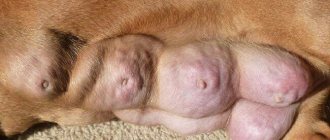Owners of female dogs carefully monitor their health, especially related to reproductive activity. Reproductive health is of great importance for animal breeders, because the good quality of the offspring and their health in the future depends on it.
The “loop” is the name given to the external genitalia of a female dog. Any discharge from the reproductive organ, if not during estrus, causes concern for owners.
Which secretions are normal, and which serve as a signal of disturbances in the body, we will consider further.
Physiological discharge from the loop
Estrus, or estrus, is an indicator of a dog's sexual maturity. According to duration, it is divided into four stages: pre-estrus, ovulation, termination and sexual rest.
Each period is accompanied by characteristic discharge from the loop.
Precursor or proestrus is a swelling of the loop and brown, bloody discharge for a week. These days you can use special panties for estrus.
Estrus (heat) is the culminating moment when ovulation occurs and the dog is allowed to mate. The secretion at this stage may be absent or light pink in color. Veterinary clinics can determine a bitch’s readiness for mating using a smear test.
Metaestrus (end of estrus) - discharge stops, the loop decreases in size.
Anestrus (sexual rest) is a period of absence of estrus, which lasts on average 100-150 days.
As a rule, the estrus cycle occurs twice a year for 10-20 days, depending on the breed of the dog.
The same natural discharge in an animal appears in the period before childbirth and in the postpartum period.
During the period associated with labor, the secreted secretion must satisfy the following characteristics:
- a maximum of two days before giving birth, the bitch notices thick discharge;
- the color of the secretion is whitish or grayish.
The listed requirements for discharge indicate the beginning of the birth process.
In the postpartum period, for two weeks (until the uterus returns to its prenatal state), brownish discharge (with a permissible blood content) may be observed for three to five days and, every day, acquiring a lighter color, until it stops completely.
Natural secretions should be transparent mucous with an acceptable content of blood impurities and not contain foreign odors or signs of inflammation.
When urine infection
Sometimes our dog has green discharge due to a urinary tract infection or cystitis. In these cases, in addition to vaginal discharge, we will observe other symptoms such as the following:
- Tension and pain when urinating.
- Our bitch may lick her vulva, usually because she feels itchy and painful.
- Hematuria (blood in urine), although not always detectable with the naked eye, sometimes we can see colored and cloudy urine.
This is a reason to consult your veterinarian because although these are usually mild conditions that respond well to antibiotics, if the bacteria is left untreated it can rise up and affect the kidneys. They are diagnosed by analyzing a urine sample. Obviously, the green discharge will disappear as the infection subsides.
© shutterstock
Discharge from the loop related to pathologies
If the functioning of any organ in a dog’s body is disrupted, then discharge from its loop can serve as a signal of a pathological process.
Pathological discharges that you need to pay attention to and immediately visit a veterinary clinic include:
- any departments during pregnancy;
- secretion secreted before childbirth is dark in color (green, yellow, brown) with a strong putrefactive odor;
- postpartum prolonged (more than a month) sticky discharge mixed with blood;
- purulent (opaque) discharge of white color, as well as a darkish shade of yellow, green, brown or red;
- the secreted secretion has a sharp, unpleasant odor;
- the appearance of drops of blood from the external genitalia.
All these discharges indicate the development of a disease, a tumor or malignant neoplasm in the genital tract or organs of the dog.
Discharge in a dog after estrus
A dog may have discharge after estrus: spotting, odorless, transparent. Only in this case is this a variant of the norm. In any situation, you need to contact a veterinarian, since discharge with a strong odor, bloody or purulent can cause serious illnesses that need to be treated urgently.
During estrus, the dog is susceptible to numerous infections, since during this period of time, the body's immunity decreases as well as its natural defenses. Infections can easily be picked up during an active walk and when interacting with other animals.
It is especially worth paying attention if there is bleeding after estrus. In this case, we may be talking about a serious illness. So do not delay your visit to the veterinarian - the sooner treatment is started, the better for your pet.
Brown discharge after heat
The owner should be especially wary if the dog has brown discharge after estrus. To find out what is causing them, you need to show your pet to a veterinarian.
Our clinic employs experienced veterinarians who will examine your dog and take tests. Having worked in veterinary medicine for many years, our doctors are qualified specialists who love animals and always try to do everything in their power to make him feel better.
The modern veterinary laboratory is equipped with everything necessary, so that the test results will be ready on the day of your visit, which means the doctor will soon be able to make a diagnosis and begin treatment for your dog.
Prices for appointments in our network of veterinary clinics
| Name of veterinary services | Unit | Price, rub |
| ⭐ Initial appointment | 1 animal | 400 |
| ⭐ Repeated appointment | 1 animal | 200 |
| Primary reception of ornamental, exotic animals, birds and reptiles | 1 animal | 1000 |
| Consultation without an animal | — | 500 |
| Consultation with a doctor based on test results | 1 PC. | 400 |











